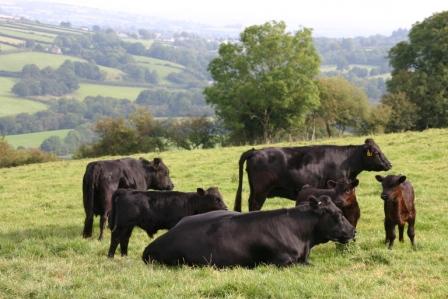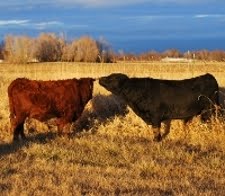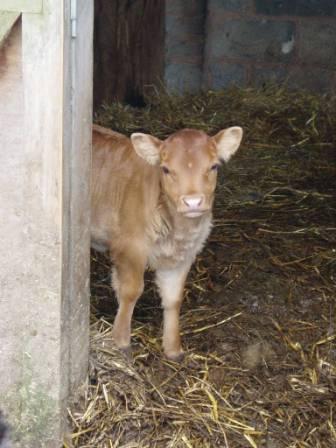


Taken From The PDCA Website
History
The Dexter cattle breed's native homeland is Ireland, although it's origins are unknown. It is commonly accepted that it is a cross between the Kerry and some other small breed, possibly the Devon. After the breed was introduced to England, it pretty much disappeared in Ireland. The breed was probably first introduced to America a long time ago, but was first recorded between 1905 and 1915 when brought over to and split into 3 herds. Progenity of both these herds can be found today.
The Dexter breed has gained popularity in both the U.K. and the U.S. in the past few decades. These gentle, hardy and easy to handle animals are one of the world's smallest bovines. They require less pasture and feed than other breeds. They thrive in hot as well as cold climates and do well outdoors year round, needing only a windbreak, shelter and fresh water. Fertility is high and calves are dropped in the field without difficulty.
Traits
The Dexter bull measures 38 to 44 inches at the shoulder and weighs around or less than 1000 pounds. A Dexter cow measures between 36 to 42 inches at the shoulder, and weighs less than 750 pounds. There are two varieties of Dexters, short legged and long legged. Short-legged animals are carriers of the chondrodysplasia, or "bulldog" mutation and should not be bred with another short-legged Dexter. Long-legged Dexters do not carry the mutation. Milk and beef production and other characteristics are generally the same for both types. The same dam and sire may produce a short legged calf in one mating and a long legged calf the next.
Dexters come in three different colors: black, red, & dun. Red or dun are highly desired because of their rarity. Dexters are typically horned, however a polled strain was developed in the 1990's. Horns on cows are fine and curved forward. Bulls' horns are thick, solid, and slightly curved at the tips. The distinctive head is short and wide between the eyes, with straight sides.
The cows are exceptionally good mothers, hiding their calves almost from birth if there is any cover to hide them in. They will produce enough milk to feed 2-3 calves, and often will willingly nurse calves from other cows. They are known for easy calving. This trait, along with the small size of the calf, has produced a small but growing market in the United States for Dexter bulls to breed to first calf heifers among the larger beef breeds to eliminate problems at parturition.
History
The Dexter cattle breed's native homeland is Ireland, although it's origins are unknown. It is commonly accepted that it is a cross between the Kerry and some other small breed, possibly the Devon. After the breed was introduced to England, it pretty much disappeared in Ireland. The breed was probably first introduced to America a long time ago, but was first recorded between 1905 and 1915 when brought over to and split into 3 herds. Progenity of both these herds can be found today.
The Dexter breed has gained popularity in both the U.K. and the U.S. in the past few decades. These gentle, hardy and easy to handle animals are one of the world's smallest bovines. They require less pasture and feed than other breeds. They thrive in hot as well as cold climates and do well outdoors year round, needing only a windbreak, shelter and fresh water. Fertility is high and calves are dropped in the field without difficulty.
Traits
The Dexter bull measures 38 to 44 inches at the shoulder and weighs around or less than 1000 pounds. A Dexter cow measures between 36 to 42 inches at the shoulder, and weighs less than 750 pounds. There are two varieties of Dexters, short legged and long legged. Short-legged animals are carriers of the chondrodysplasia, or "bulldog" mutation and should not be bred with another short-legged Dexter. Long-legged Dexters do not carry the mutation. Milk and beef production and other characteristics are generally the same for both types. The same dam and sire may produce a short legged calf in one mating and a long legged calf the next.
Dexters come in three different colors: black, red, & dun. Red or dun are highly desired because of their rarity. Dexters are typically horned, however a polled strain was developed in the 1990's. Horns on cows are fine and curved forward. Bulls' horns are thick, solid, and slightly curved at the tips. The distinctive head is short and wide between the eyes, with straight sides.
The cows are exceptionally good mothers, hiding their calves almost from birth if there is any cover to hide them in. They will produce enough milk to feed 2-3 calves, and often will willingly nurse calves from other cows. They are known for easy calving. This trait, along with the small size of the calf, has produced a small but growing market in the United States for Dexter bulls to breed to first calf heifers among the larger beef breeds to eliminate problems at parturition.
About Dexters
Cantrell Farms
Home | About Us | Contact Us



Some Images from North Fork Dexters
http://www.northforkdexters.com
http://www.northforkdexters.com